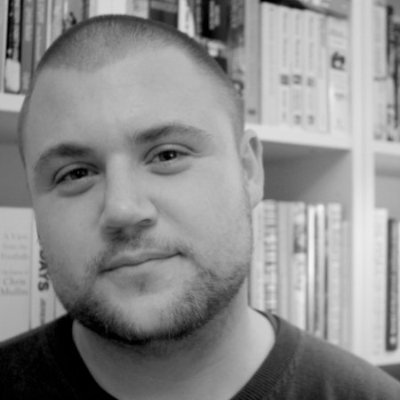
('The Puppet Maker' © Jose Maria Cuellar, 2015)
*
EDITORS DOs AND DON’Ts
by GARY BUDDEN & GEORGE SANDISON
~
Gary Budden and George Sandison, the editors of Unsung Stories – publishers of literary and ambitious speculative fiction – share their tips on submitting to literary journals and magazines, and how to accept that dreaded rejection letter.
~ *
FROM GARY
 During my time on the Ambit magazine fiction editorial team, we received a huge number of submissions – a small but memorable minority falling into the ‘odd and baffling’ category. But the one that sticks out most, as a prime example of what not to do when sending in a piece of short fiction, was relatively simple in terms of what was wrong. The cover letter began with: Dear J.G. Ballard…
During my time on the Ambit magazine fiction editorial team, we received a huge number of submissions – a small but memorable minority falling into the ‘odd and baffling’ category. But the one that sticks out most, as a prime example of what not to do when sending in a piece of short fiction, was relatively simple in terms of what was wrong. The cover letter began with: Dear J.G. Ballard…
This was in 2012. It’s worth remembering that Ballard died in 2009, and had ceased his editorial involvement with the magazine a long time before that. 1988, to be precise. That submission may have been a fantastic story; but I will never know as it was rejected immediately, for what I hope are obvious reasons.
What’s the lesson to be learned here? Mainly, make sure you do your research – and check before you send that email! I’ve seen many submissions where it is immediately obvious that the author has been cut-and-pasting a stock email whilst sending out multiple submissions (which is fine, as long as simultaneous submissions are accepted by the particular magazine).
This will not do you any favours, and neither will any of the following mistakes we often see at Unsung Stories when we’re reading through the slushpile, looking for the next great piece of short fiction we want to publish.
Most places asking for short story submissions will ask for an accompanying author biography and a cover letter. There are good and bad ways to do this, but the key point is not to fret and keep it simple.
When it comes to your author bio, you don’t have to tell us your life story; we don’t need to know how many cats you have and what their names are. Your name and where you live is enough for us – if we do like the story and decide to accept it, we’ll ask for a full bio then.
I’d advise against telling us how your work is an insightful, nuanced and deep exploration of complex themes – if it’s true we’ll be able to get that from the story itself. You don’t need to send us a list of every place you’ve ever been published, going back to that piece you had in the student paper in 1999 – just a short list of relevant magazines and journals (and any books you’ve had published, of course) will do.
Personally (and other editors may disagree here), I would say avoid trying to be funny in any bio or cover letter, as it can easily backfire. Keep the information relevant, short and without unnecessary digression. The reality is an editor will be looking at large numbers of submissions every week, and what is most important is the quality of the story itself. Bios and cover letters that detract from this will only harm your chances.
Another very important point: make sure you read the submission guidelines. If it says the maximum word count for a story is 2,500 words, don’t send in your new 17,000 word novella. There will be a reason, especially for print mags, for specifying the word count, and that reason is space. Simple really.
For writers at the beginning of their career, the issue of rejection can be a difficult one – and, unfortunately, an inevitability. With my own writing, I have had work accepted and published in various places, but have received a considerably greater number of rejections. As an editor I have read many hundreds of short story submissions during my time, most of which will have been rejected. It’s simply just part of the whole process. And not one we enjoy either; it’s never fun disappointing people.
What I’d really like to stress is: don’t take it personally. Sometimes the story is just not the right fit for the publisher or the magazine. Sometimes one editor loved it, but it the other two didn’t. There are many reasons why your story does not get accepted, and it shouldn’t be disheartening; there are things you can learn from the process. If one particular story is getting rejected from every place you send it to, the most logical thing to do is go back to that story and accept it probably needs a rewrite. If editors do send some feedback with their response, listen to it. And if you get sent an encouraging rejection (which is actually quite a rare thing) take it as a real positive! It means the editors liked your work a lot, but it wasn’t quite right this time around. It means they’d like to see more.
And if you do get a rejection, don’t send us an angry email pointing out why we’re wrong to do so… we’ll remember you for all the wrong reasons.
The key point is to keep going, keep writing, keep submitting, and learn as you go.
~
FROM GEORGE
 Rejection. It’s an inevitable part of the submission process. The cause of cathartic griping sessions on Twitter and that inevitable anecdote about J.K. Rowling. A source of frustration. The thing that can put sensitive souls off writing.
Rejection. It’s an inevitable part of the submission process. The cause of cathartic griping sessions on Twitter and that inevitable anecdote about J.K. Rowling. A source of frustration. The thing that can put sensitive souls off writing.
So let’s deal with rejection. Here is everything you need to know…
1. It will happen to you. It’s happened to us. It is an essential part of being a writer. Don’t be beaten down by it, embrace it as an opportunity to learn. Keep going.
2. Editors are people – actual human beings with hearts and a conscience and everything – and they don’t get a dirty kick out of turning things down. There is no conspiracy against you, a distinct lack of moustache-twiddling, and a frank absence of maniacal laughter.
3. A form rejection doesn’t mean we hated the story. It means the editor doesn’t have time to write one hundred personally crafted responses. A few markets do offer feedback on everything – which is a wonderfully generous, and slightly insane, approach – but most don’t because there simply isn’t time.
4. Know the acceptance rates. Unsung Shorts takes 4.7% of stories submitted* and it gets lower for more famous markets. That’s fewer than five out of every hundred stories. So don’t take it personally; there are ninety-five other people in the same position as you.
5. A personal rejection is great news. Stop looking at the rejection bit and focus on the personal. The staff want to talk to you personally, maybe offer some feedback. We really do want to see more, we’re not just saying it to be nice. Remember the second point: imagine how pleased we are when someone submits again and nails it.
6. However you feel, take it with grace. Replying with thanks, or acknowledgement is fine, but think carefully about sending anything like, ‘Actually, it was accepted by Blah and Blah’. It most often sounds bitter and you’re putting a torch to the bridge by doing that, for no reason.
As a parting thought, here’s our form rejection:
Thank you for letting us read through your work, and best of luck with finding a home for it. The short story is a complex thing to compose – disproportionately so compared to the final word count – and the best advice we can offer is to persevere. Every editor responds to things differently and it’s a subjective market so there’s nothing to say someone else won’t pick up this story in the future.
That’s not an elegant fobbing off, it’s the truth. Chin up.
~
Gary Budden is editor at Unsung Stories. His work has appeared in Structo, Elsewhere, Unthology, The Lonely Crowd, Gorse, Galley Beggar Press, and many others. He writes regularly for Unofficial Britain and blogs about landscape punk at www.newlexicons.com.
George Sandison is Managing Editor for Unsung Stories. @GeorgeSandison www.georgesandison.com
~
* from the Submission Grinder, October 2016.

